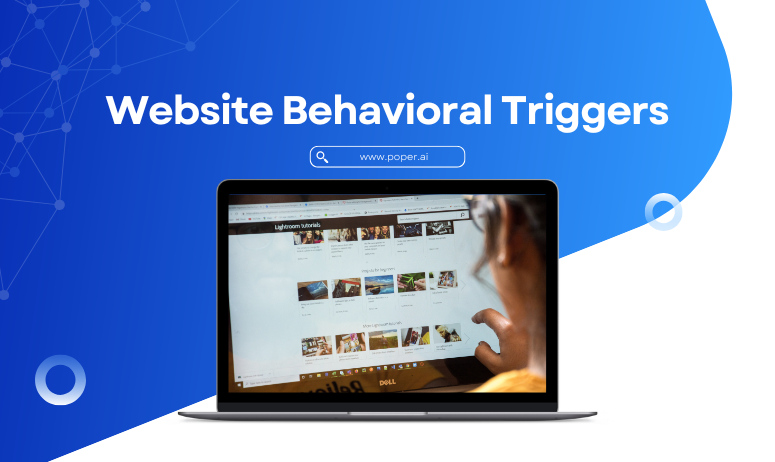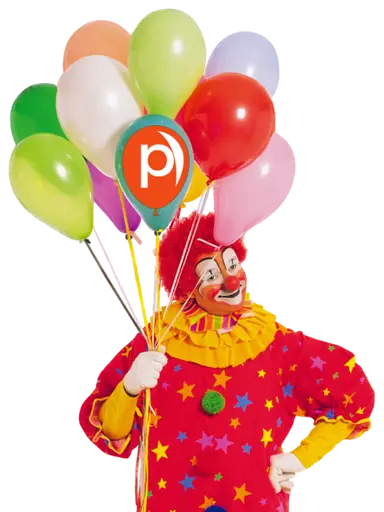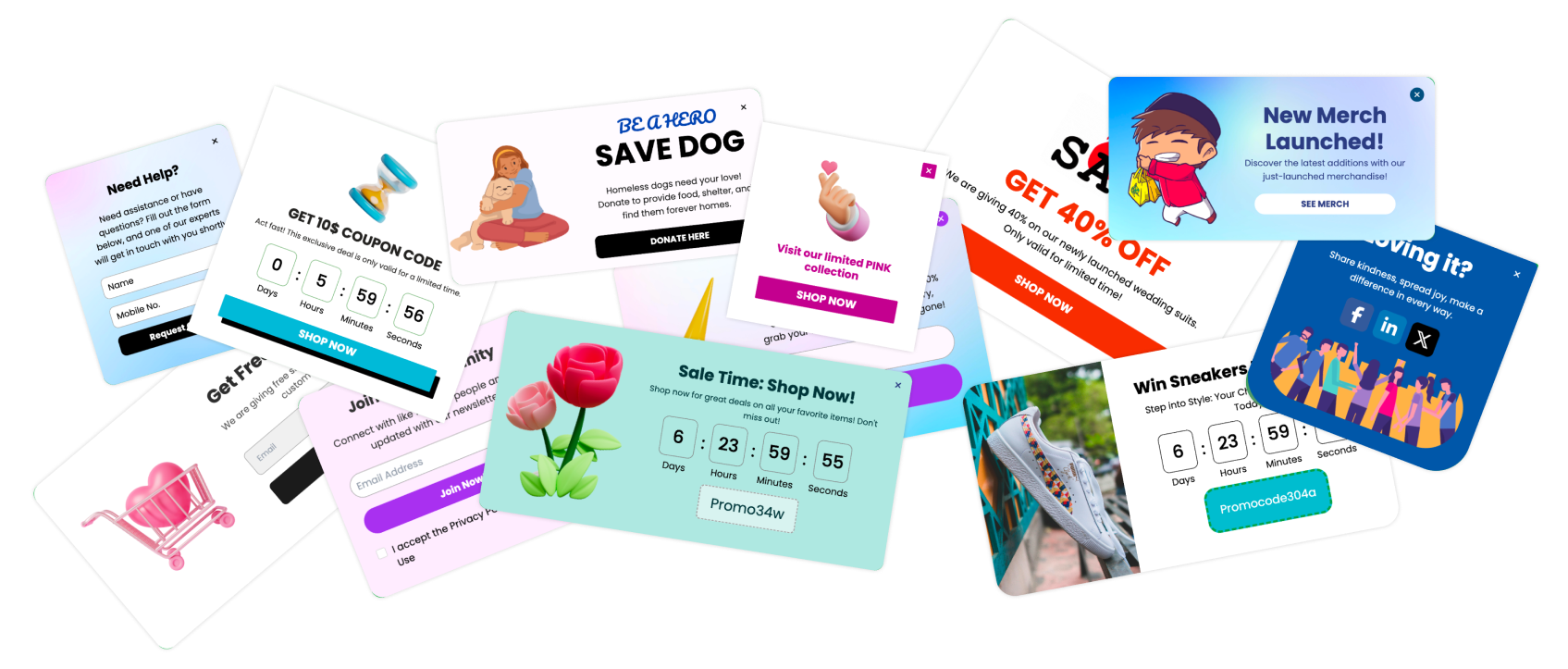"Engagement is not about pushing content; it’s about responding to user intent at the right moment."
Website behavioral triggers are automated actions that respond to specific user behaviors on your website. Unlike generic popups that appear randomly or after a fixed time, behavioral triggers are context-aware, personalized, and designed to interact with users based on their actual behavior. They can appear when a user scrolls halfway down a page, attempts to leave, clicks a certain button, or abandons a form.
Why do they matter? Traditional website experiences are often passive. Users browse, scroll, and leave without meaningful interaction. Behavioral triggers convert passive visits into active engagement by providing timely offers, guidance, or interactive content exactly when a user is most likely to respond. This approach boosts conversions, reduces bounce rates, and enhances user satisfaction, making your website a smarter and more dynamic platform.
Key Advantages of Behavioral Triggers
| Advantage | Description | Example |
|---|---|---|
| Engagement | Converts passive browsing into interaction | Scroll-triggered popup with related content |
| Conversion | Captures leads or drives purchases | Exit-intent discount popup |
| Personalization | Responds to individual user behavior | Product recommendation popup based on viewed pages |
| Retention | Encourages repeat visits and loyalty | Gamified reward popup for returning users |
The 11 Most Effective Website Behavioral Triggers
Behavioral triggers turn passive visitors into engaged users by responding to their actions in real-time. When used correctly, they can dramatically improve engagement, lead generation, and conversions. Below, we explore the 11 triggers that every website should consider, with practical examples and tips.
1. Scroll Depth Triggers – Engage Users as They Scroll
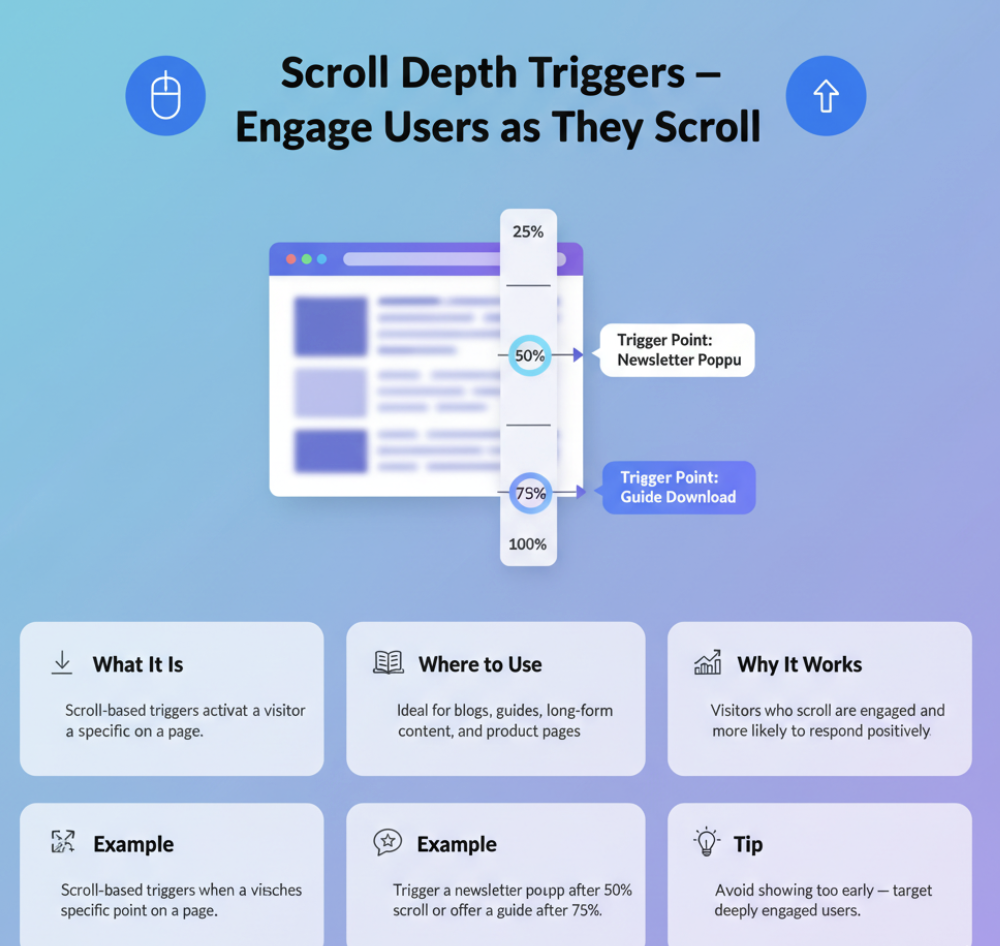
Scroll-based triggers activate when a visitor reaches a specific point on a page. They are ideal for blogs, guides, long-form content, and product pages.
Why it works: Visitors who scroll are already engaged and invested in the content. This makes them more likely to respond positively to a popup or offer.
Example: On a long blog post, trigger a newsletter signup popup after the user scrolls 50% of the page. Alternatively, offer a related guide after 75% scroll.
Tip: Avoid showing too early; aim for points where users are deeply engaged but haven’t yet converted.
2. Exit-Intent Triggers – Capture Visitors Before They Leave
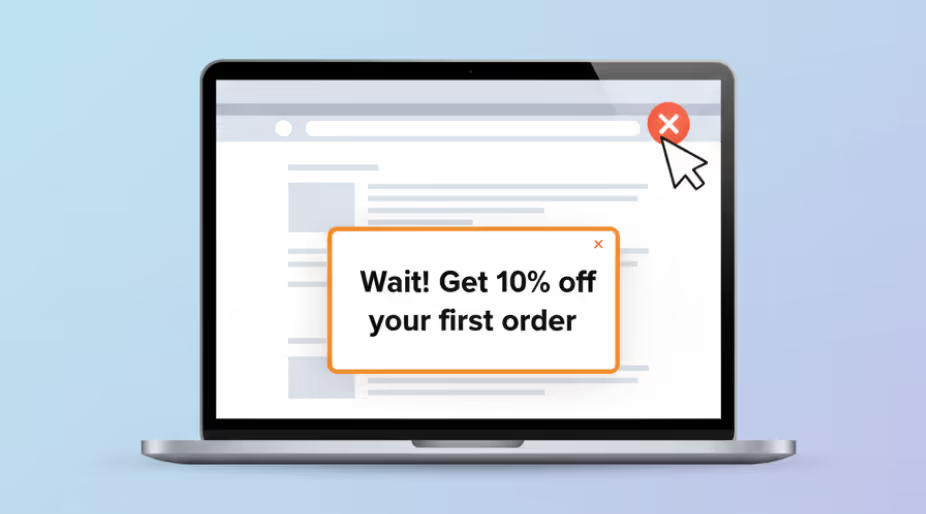
Exit-intent triggers detect when a user is about to leave the website and display a targeted message.
Why it works: It gives one final chance to engage a visitor who may have left without interacting.
Example: Show a limited-time discount or free resource when the cursor moves toward the browser’s close button. For e-commerce, offer free shipping or a bonus gift to retain the potential customer.
Tip: Combine with urgency messaging to increase conversion chances.
3. Time-Based Triggers – Target Users After a Certain Time
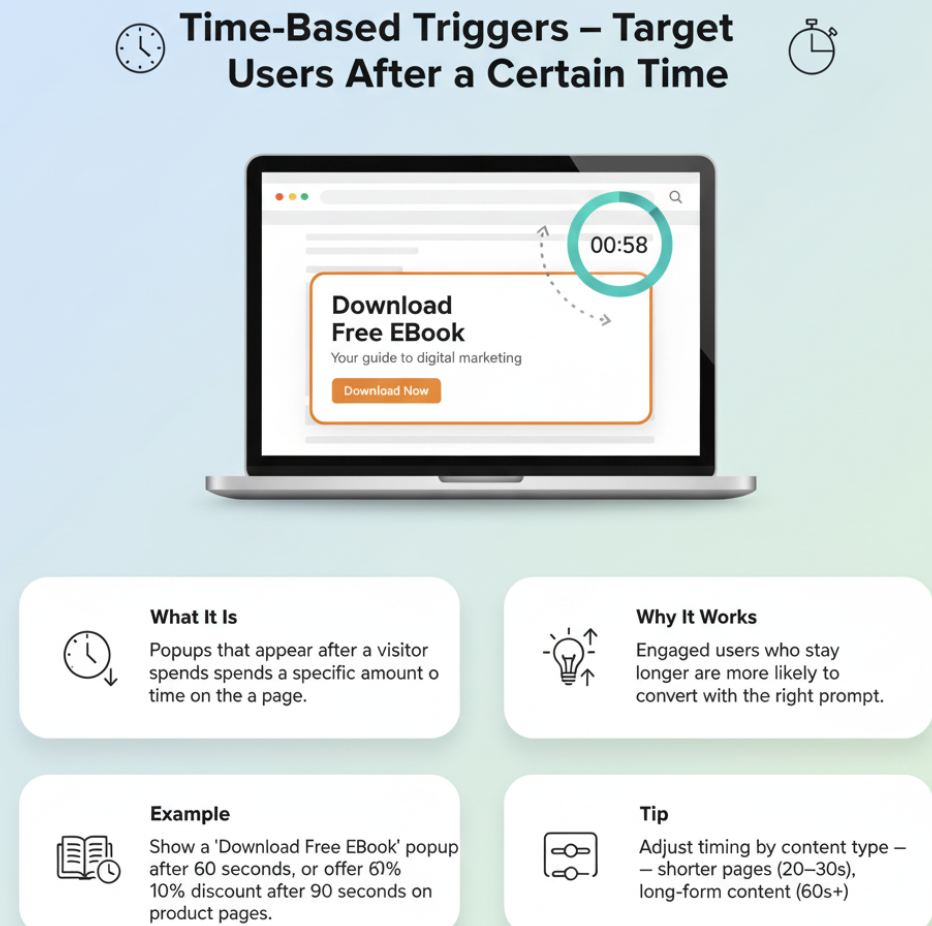
These popups appear after a visitor spends a predetermined amount of time on a page.
Why it works: Users who stay on a page for a certain duration are often interested but may need a prompt to take action.
Example: Display a “Download Your Free eBook” popup after 60 seconds on a guide or product page. On product pages, offer a 10% discount after 90 seconds.
Tip: Adjust timing based on content length; shorter pages may need 20–30 seconds, while long-form content may require 60+ seconds.
4. Click-Based Triggers – Respond to User Interactions
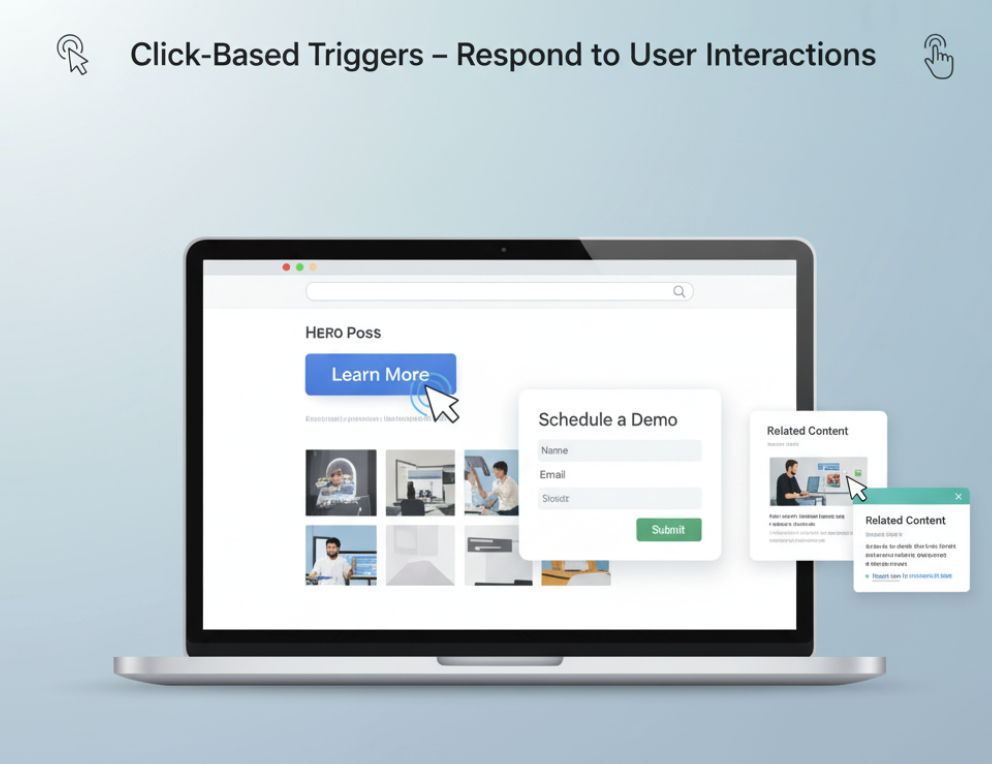
Click-based triggers fire when a visitor clicks a specific button, link, or image.
Why it works: The visitor is already showing intent, making the popup or message highly relevant.
Example: Clicking “Learn More” about a product triggers a popup with a demo signup form. Clicking a blog article image could trigger a related content suggestion.
Tip: Use click-based triggers sparingly to avoid interrupting user flow.
5. Form Abandonment Triggers – Recover Lost Leads
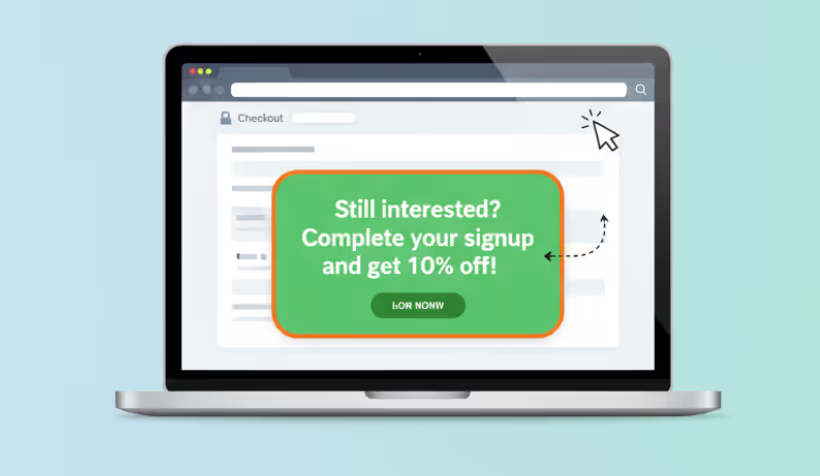
Form abandonment triggers appear when a user begins filling a form but leaves before submitting.
Why it works: Many users intend to complete a form but get distracted or hesitate. A well-timed trigger can recover these leads.
Example: A visitor abandons a signup form halfway; a popup offers a small incentive or reminds them to complete the form. In e-commerce, a discount for incomplete checkout forms works similarly.
Tip: Use concise, clear messaging to reduce friction.
6. Page-Specific Triggers – Contextual Popups for Relevant Pages
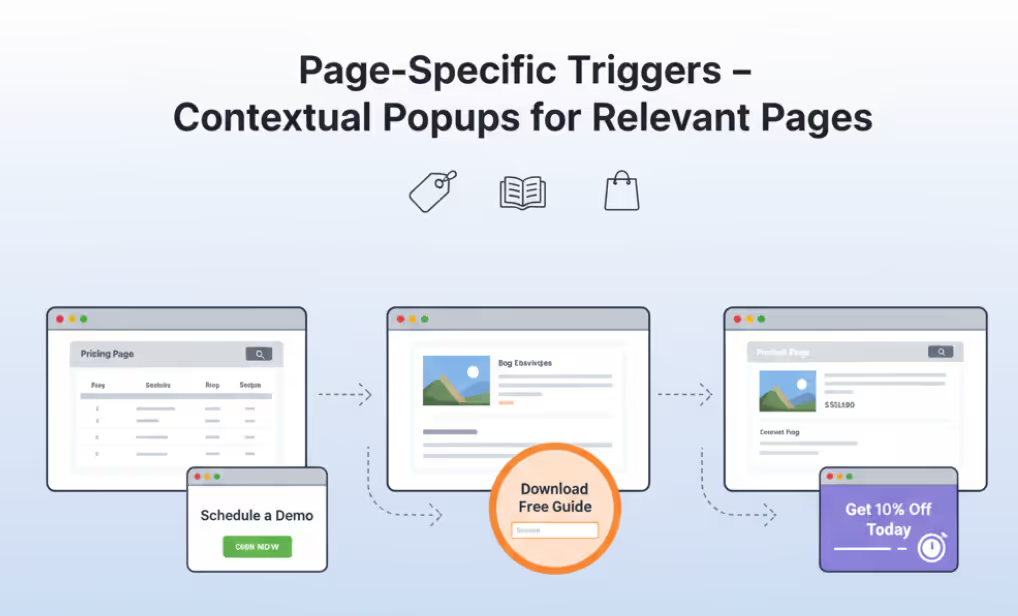
Page-specific triggers are tailored to the content or purpose of a specific page.
Why it works: Relevance increases user engagement because the message directly matches their current intent.
Example: On a pricing page, trigger a “Schedule a Demo” popup. On a blog page, show a newsletter signup or free guide related to the article topic.
Tip: Avoid generic messaging; align offers closely with page content.
7. Engagement-Based Triggers – Reward Content Interaction
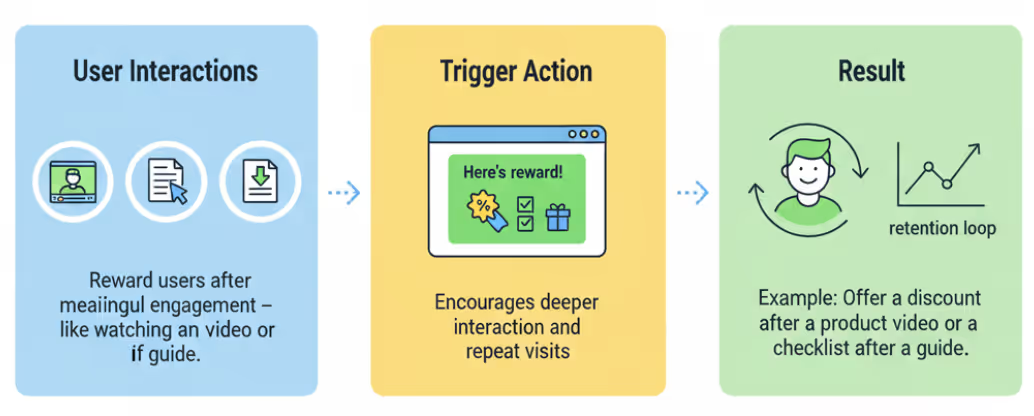
These triggers reward or engage users based on interactions like video plays, reading time, or downloads.
Why it works: Positive reinforcement encourages deeper engagement and return visits.
Example: After watching a product video, show a popup offering a discount code. After reading a guide completely, offer a free checklist download.
Tip: Track user activity to trigger only after meaningful interaction, not just superficial clicks.
8. Cart Abandonment Triggers – Re-Engage Potential Buyers
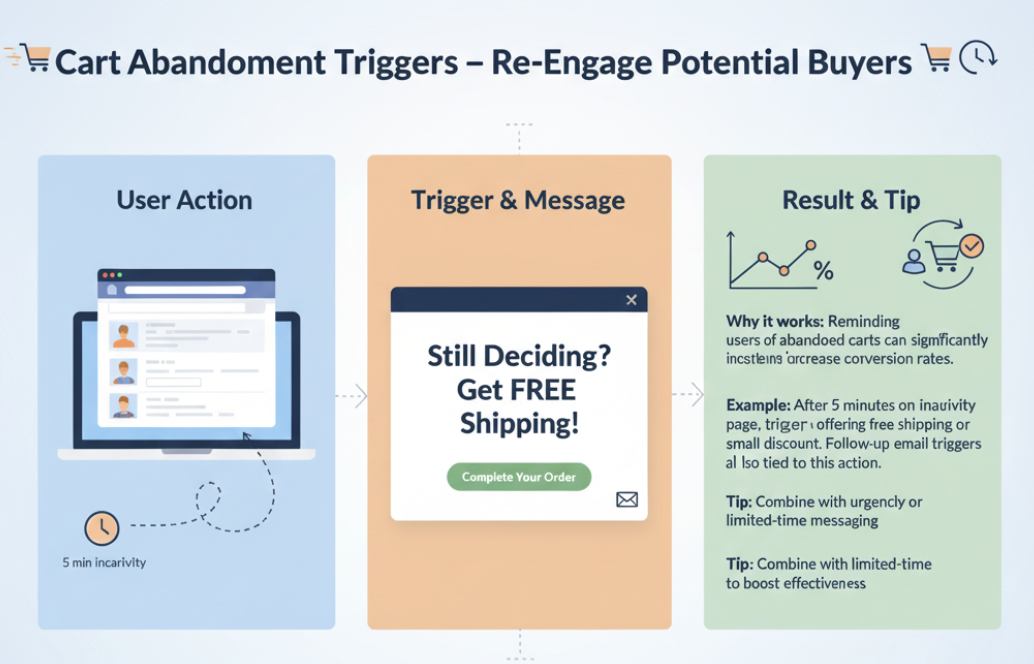
Cart abandonment triggers are crucial for e-commerce, targeting users who leave items in their cart without completing purchase.
Why it works: Reminding users of abandoned carts can significantly increase conversion rates.
Example: After 5 minutes of inactivity on a checkout page, trigger a popup offering free shipping or a small discount. Follow-up email triggers can also be tied to this action.
Tip: Combine with urgency or limited-time messaging to boost effectiveness.
9. Gamified Triggers – Make Engagement Fun
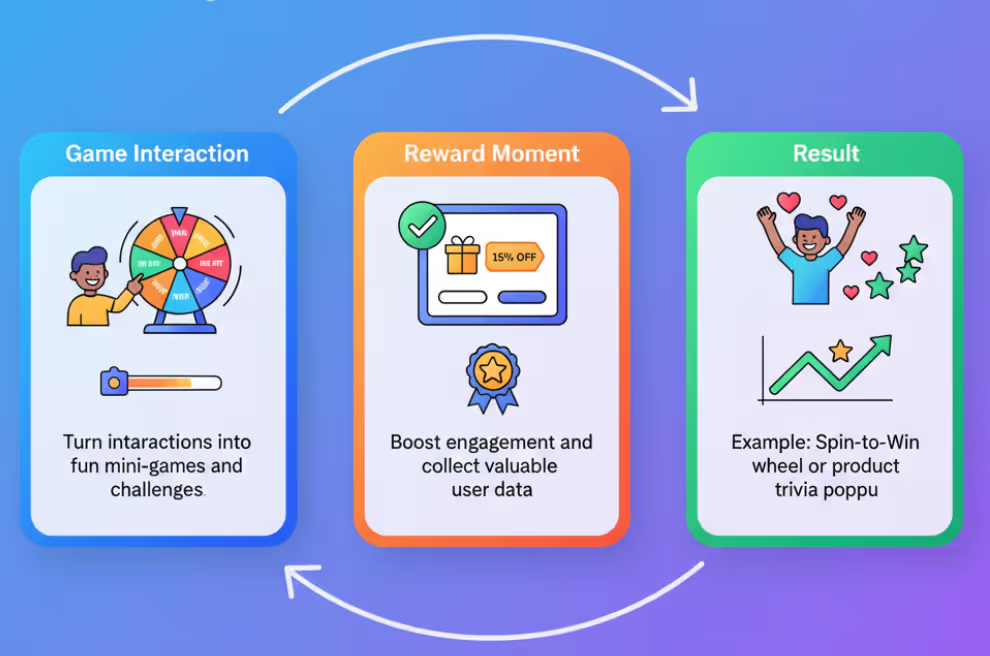
Gamified triggers turn interactions into mini-games, quizzes, or challenges that reward users.
Why it works: Games create memorable, enjoyable experiences that encourage participation and data capture.
Example: A “Spin to Win” wheel that offers discounts in exchange for an email. Trivia or quiz popups related to your products also work well.
Tip: Keep mechanics simple and rewards meaningful to maintain engagement without causing frustration.
10. Loyalty and Reward Triggers – Encourage Repeat Visits
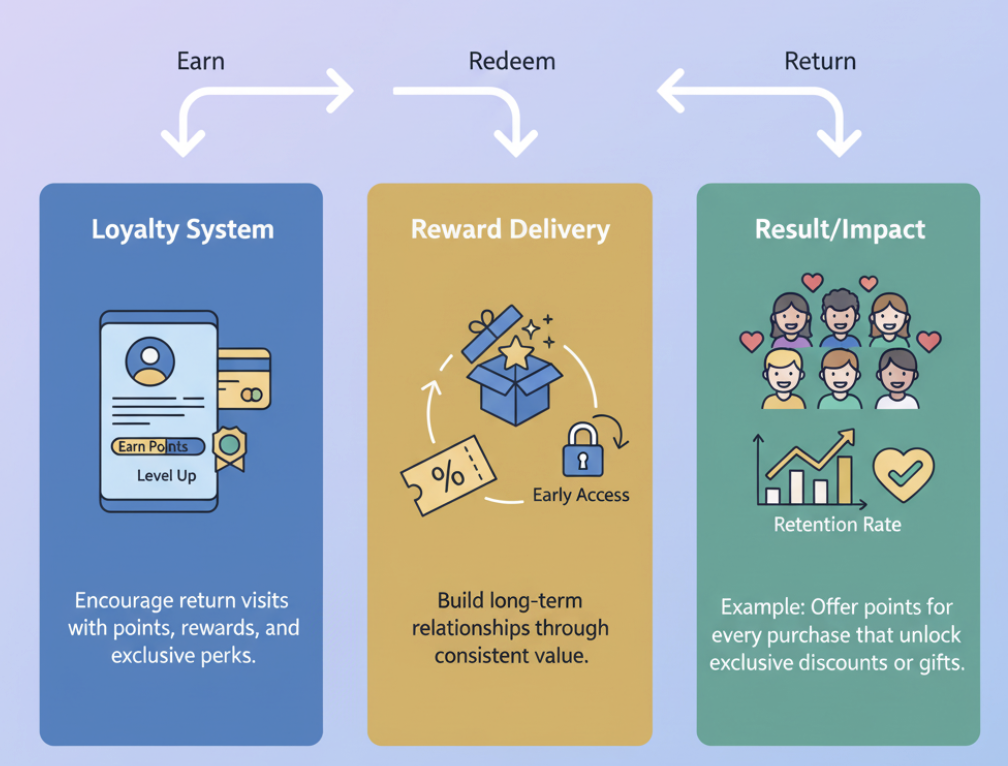
These triggers target returning users with rewards, points, or exclusive offers to reinforce loyalty.
Why it works: Repeat visitors are more likely to convert if they feel valued and rewarded.
Example: Trigger a popup offering loyalty points or a special discount for users visiting a website three or more times. Gamified badges or progress bars work well here.
Tip: Use analytics to segment loyal users and personalize rewards effectively.
11 Onboarding and Tutorial Triggers – Guide New Users
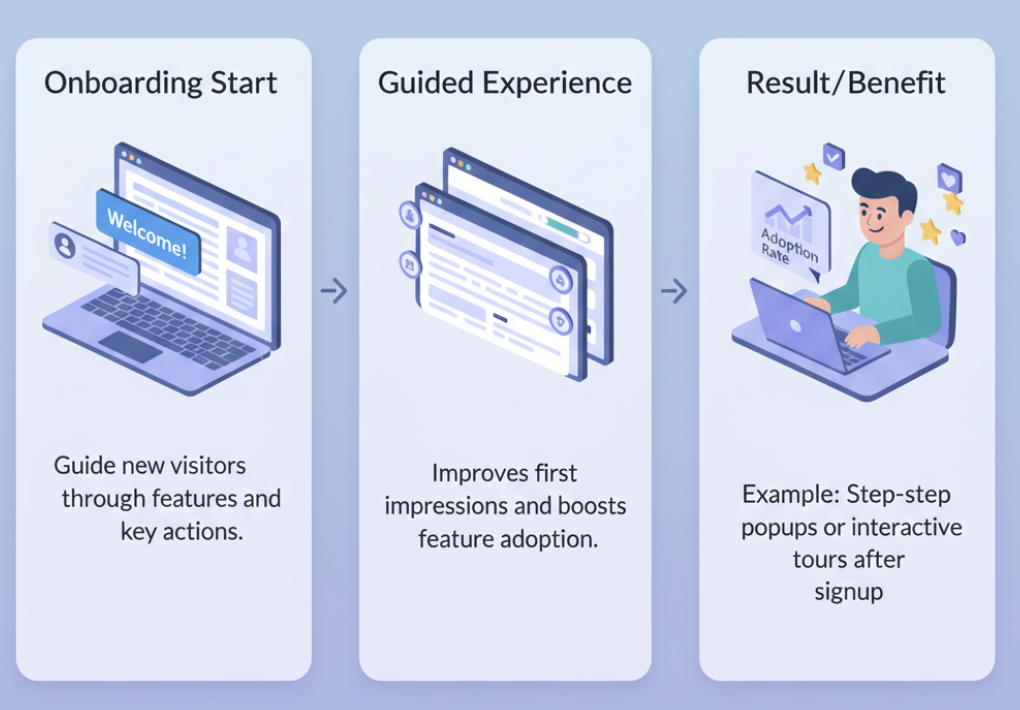
Onboarding triggers help new visitors understand your site, features, or products through guidance and tutorials.
Why it works: Clear onboarding reduces confusion, improves first impressions, and increases feature adoption.
Example: After signing up, trigger a step-by-step guide popup highlighting key features. In SaaS platforms, show tooltips or interactive tours for new users.
Tip: Make onboarding interactive and concise to avoid overwhelming new users.
How Behavioral Triggers Work
Behavioral triggers are not random—they work by analyzing user actions and delivering the right message at the right moment. Understanding how they function is key to using them effectively and maximizing engagement and conversions.
Mapping Triggers to the User Journey
Every user goes through a journey on your website: discovery, consideration, and conversion. Behavioral triggers should be mapped to these stages to provide contextually relevant engagement:
| User Stage | Example Trigger | Goal |
|---|---|---|
| Discovery | Scroll Depth Trigger | Capture interest with related content or newsletter signup |
| Consideration | Time-Based Trigger | Present offers or demos after user engagement |
| Conversion | Exit-Intent / Cart Abandonment | Recover potential leads or buyers before they leave |
By aligning triggers with user intent, you ensure that popups feel helpful rather than intrusive.
Trigger Timing and Conditions
Timing is everything. Behavioral triggers should fire based on real-time interactions rather than fixed schedules. Common conditions include:
Scroll depth: Trigger after 50–75% of page scroll
Time spent: Trigger after a user has been on the page for 30–90 seconds
Mouse movement: Exit-intent detection when cursor moves toward the close button
Click action: Trigger after clicking specific buttons or links
Personalization and Dynamic Messaging
Behavioral triggers work best when they feel personal. Personalized triggers consider:
User location or language
Past behavior on your website
Pages visited or products viewed
Returning vs new visitors
Example: A returning visitor sees a popup offering a loyalty reward, while a new visitor gets an onboarding guide. Dynamic content improves relevance, increasing the chance of conversion by 2–3x.
Measuring Impact on Conversions
Tracking is essential to optimize behavioral triggers. Key metrics include:
Engagement rate: How many users interacted with the trigger
Conversion rate: How many completed a desired action
Bounce rate reduction: Did triggers reduce exits?
Lead generation: Number of emails, signups, or form submissions
Implementing Behavioral Triggers with Poper
Poper makes it simple to create and manage behavioral triggers without any coding. Its intuitive platform allows you to design, customize, and launch triggers that respond to user behavior in real time, maximizing engagement and conversions.
Overview of Poper’s Trigger Builder
Poper’s Trigger Builder is a no-code, drag-and-drop interface where you can create popups, nudges, and gamified experiences based on user actions. It offers:
Pre-built templates for scroll, exit, time, click, and gamified triggers
Customizable branding for colors, logos, and messaging
Advanced targeting to show triggers only to specific segments of users
Why it matters: Instead of guessing what works, you can experiment with different triggers, track performance, and optimize quickly.
Selecting the Right Trigger Type for Your Goal
Choose triggers based on your objectives:
Lead generation: Scroll-depth, time-based, or gamified triggers
Sales conversions: Cart abandonment, exit-intent, and click-based triggers
User onboarding or engagement: Onboarding tutorials, page-specific, or engagement-based triggers
Example: For a SaaS platform, a scroll-triggered popup offering a free trial guide might perform better than an exit-intent popup.
Customizing Popups, Messages, and Games
With Poper, you can fully customize your triggers to match your brand:
Upload logos and brand colors
Edit messaging to be persuasive and concise
Add images, GIFs, or videos for richer interaction
Create gamified popups, such as spin wheels or quizzes, for email capture or reward distribution
Setting Trigger Conditions (Scroll, Time, Exit, Click, etc.)
Poper allows you to define exact conditions for when a trigger appears:
Scroll depth: Trigger after 50%, 75%, or full scroll
Time-based: Show after 30–90 seconds on page
Exit-intent: Detect mouse movement toward closing the tab or leaving the site
Click-based: Fire after button or link clicks
Capturing Leads and Integrating with CRM/Email
Behavioral triggers are most valuable when they capture actionable data:
Collect emails, phone numbers, or other lead info
Automatically sync with your email platform or CRM
Use Poper’s analytics to track performance of each trigger
Example: A gamified “Spin to Win” popup captures email addresses, then automatically adds them to your email campaign. This allows seamless follow-up and increases the likelihood of conversions.
Best Practices for Using Behavioral Triggers
Behavioral triggers can significantly boost engagement and conversions—but only if implemented thoughtfully. Following best practices ensures that your triggers enhance the user experience rather than annoy visitors.
Keep Popups Relevant and Non-Intrusive
Relevance is key. A popup should provide value, not just appear for the sake of showing something.
Match the trigger to the page content or user behavior.
Avoid showing multiple popups at once.
Focus on helping users complete a goal, such as downloading a guide, signing up, or making a purchase.
Example: A scroll-triggered popup offering a related article is more effective than a generic discount offer on every page.
Ensure Mobile Responsiveness
Most users browse on mobile devices. A popup that isn’t mobile-friendly can hurt user experience and reduce conversions.
Use responsive design for all triggers.
Ensure buttons are easy to tap and forms are simple.
Avoid covering the entire screen unnecessarily.
Be Transparent About Offers and Rewards
Trust is critical. Users are more likely to interact with triggers if they clearly understand the offer.
Show reward details upfront, such as discount value or prize conditions.
Avoid misleading language or hidden terms.
Example: In a gamified spin-the-wheel popup, clearly display prize options and probabilities to maintain trust.
Test and Optimize Triggers Regularly
Behavior changes over time. Continuous testing helps you identify which triggers and messaging perform best.
Use A/B testing for different triggers, designs, and messages.
Track metrics like engagement, conversions, and dwell time.
Adjust trigger timing and conditions based on user behavior data.
Balance Frequency to Avoid User Frustration
Too many popups can annoy users and increase bounce rates.
Limit the number of triggers per session.
Consider showing triggers only to new visitors or after certain actions.
Use smart targeting to avoid repeating the same popup for the same user.
Example: Show an exit-intent discount popup once per session, not every time a user navigates to a new page.
Common Mistakes to Avoid
Even the best behavioral triggers can backfire if not implemented carefully. Avoiding these common mistakes ensures a positive user experience and maximizes your engagement and conversion potential.
Trigger Overload
Showing too many popups or messages at once overwhelms users.
Avoid bombarding visitors with multiple triggers on the same page or session.
Prioritize triggers based on user behavior and business goals.
Example: Don’t show a newsletter popup, an exit-intent discount, and a gamified quiz simultaneously. Choose the one that aligns with the user’s current intent.
Misaligned Triggers with User Intent
Triggers that don’t match what the user wants can annoy or confuse them.
Ensure triggers correspond to the user’s stage in the journey.
Avoid generic popups that appear irrespective of user actions.
Example: Offering a discount to a new visitor who hasn’t explored products yet may feel irrelevant; instead, offer a helpful guide or onboarding content.
Ignoring Analytics and Data
Without measuring results, you won’t know what works.
Track engagement, conversions, and dwell time for each trigger.
Adjust your triggers based on real data rather than assumptions.
Poor Mobile Optimization
Many websites fail to optimize popups for mobile users.
Ensure triggers are responsive and visually appealing on smaller screens.
Avoid popups that cover the entire screen or are difficult to dismiss.
Example: A gamified quiz that is too large for mobile screens may frustrate users and lead to abandonment.
Overcomplicating Trigger Mechanics
Complex triggers or confusing messaging can reduce engagement.
Keep instructions clear and simple.
Avoid unnecessary steps or multiple actions before users can engage.
Example: A multi-step quiz with unclear rules can frustrate users—opt for single-step, easy-to-understand interactions.
Metrics to Measure Success
Measuring the impact of behavioral triggers is essential for understanding performance and optimizing results. By tracking the right metrics, you can see which triggers drive engagement, leads, and conversions.
Plays, Clicks, and Engagement Rates
Engagement metrics show how users interact with your triggers.
Plays or impressions: How many users saw the popup or trigger.
Clicks or interactions: How many users engaged by clicking, spinning, or submitting information.
Engagement rate: Percentage of users who interacted compared to total visitors.
Example: A gamified spin-the-wheel popup may have 2,000 impressions and 400 interactions, giving a 20% engagement rate.
Conversions and Lead Submissions
Conversion metrics measure whether triggers achieve their goal.
Track completed actions like form submissions, email captures, purchases, or downloads.
Compare conversion rates across different trigger types and timings.
Example: An exit-intent popup offering a 10% discount may convert 8% of abandoning users into buyers.
Bounce and Exit Rates
These metrics indicate whether triggers reduce user drop-off.
Lower bounce rates suggest that users stay longer due to engagement triggers.
Exit rates can be analyzed before and after implementing triggers to measure their effectiveness.
Dwell Time and Interaction Depth
These metrics measure user engagement beyond clicks.
Track how long users stay on a page after interacting with a trigger.
Measure the depth of interaction, such as completing quizzes or reading suggested content.
Example: A content recommendation popup triggered at 50% scroll may increase average dwell time from 2 minutes to 4 minutes.
ROI Attribution
Ultimately, triggers should drive tangible business outcomes.
Attribute leads, signups, or purchases to specific triggers.
Calculate ROI by comparing revenue or lead value against the cost of implementing triggers.
Summary
Behavioral triggers are a game-changer for websites, turning passive visitors into engaged users and driving measurable conversions. By implementing the 11 key triggers, personalizing experiences, and tracking results, brands can create timely, relevant, and interactive engagements that stand out in a crowded digital landscape. Platforms like Poper make this process easy, offering no-code solutions for designing, launching, and optimizing behavioral triggers effectively.
FAQs
What is a website behavioral trigger?
A behavioral trigger is an automated action on a website that responds to user behavior, such as scrolling, clicking, or leaving the page, to increase engagement or conversions.
How do I choose the right trigger for my site?
Analyze your user journey, identify key engagement points, and select triggers that match user intent at each stage—discovery, consideration, or conversion.
Can behavioral triggers be personalized?
Yes, triggers can be customized based on user behavior, location, device, or interaction history, making them more relevant and effective.
How do I measure the success of behavioral triggers?
Track metrics like engagement rate, conversions, bounce rate reduction, dwell time, and ROI attribution to evaluate performance and optimize triggers.
Are behavioral triggers mobile-friendly?
Yes, but proper responsive design is essential. Triggers must be visually clear, easy to interact with, and non-intrusive on all devices.


